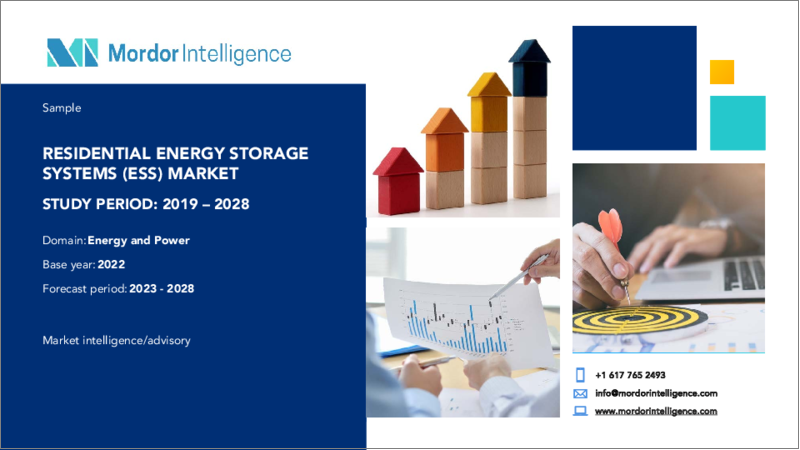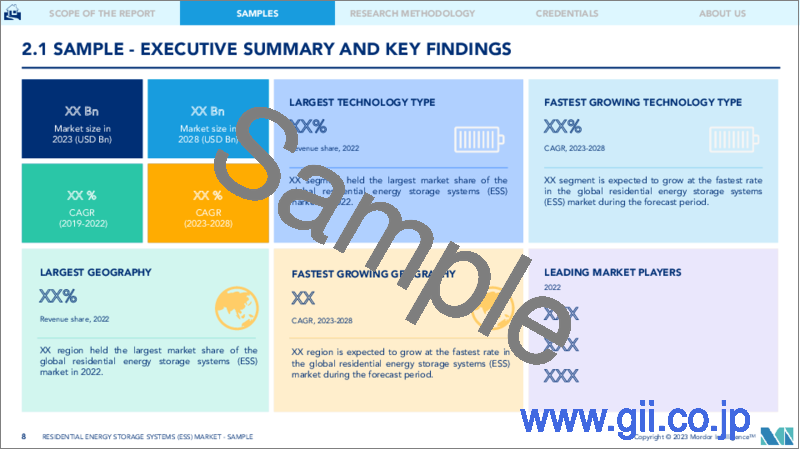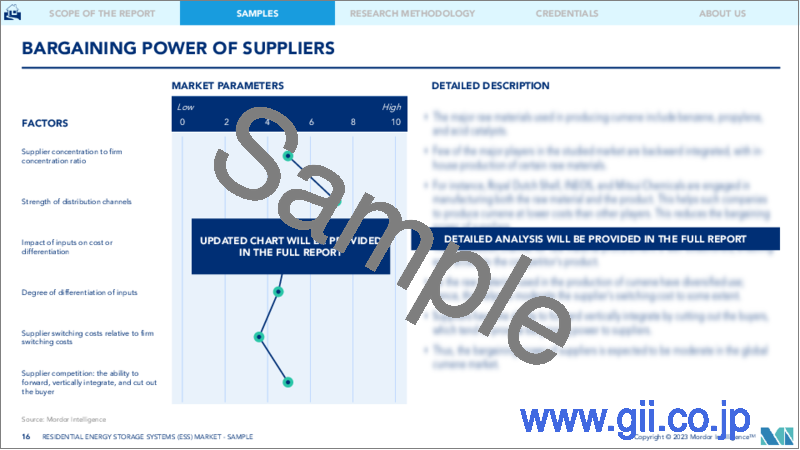|
|
市場調査レポート
商品コード
1198205
住宅用エネルギー貯蔵システム(ESS)市場- 成長、動向、予測(2023年~2028年)Residential Energy Storage Systems (Ess) Market - Growth, Trends, and Forecasts (2023 - 2028) |
||||||
|
● お客様のご希望に応じて、既存データの加工や未掲載情報(例:国別セグメント)の追加などの対応が可能です。 詳細はお問い合わせください。 |
|||||||
| 住宅用エネルギー貯蔵システム(ESS)市場- 成長、動向、予測(2023年~2028年) |
|
出版日: 2023年01月23日
発行: Mordor Intelligence
ページ情報: 英文 180 Pages
納期: 2~3営業日
|
- 全表示
- 概要
- 目次
住宅用エネルギー貯蔵システム市場は、年末までに43億8000万米ドルに達し、予測期間中に24.4%以上のCAGRで推移すると予測されています。
市場は、2020年にCOVID-19の影響を受けました。現在、市場はパンデミック前の水準に達しています。
主なハイライト
- 中期的には、無停電で信頼性の高い電力供給に対する需要の増加や、住宅部門によるソーラールーフトップシステムの導入の増加も、調査対象市場の成長を促進すると予想されます。
- 一方、多くの国で電池製造用の金属資源や埋蔵量に直接アクセスできないことは、市場の成長にマイナスの影響を与える可能性があり、市場の主要な抑制要因の1つとなっています。
- とはいえ、住宅用エネルギー貯蔵システム市場は、ドイツ、米国、オーストラリアなどの先進国が主に支配しています。しかし、ブラジル、サウジアラビア、タイ、バングラデシュなど他の数カ国は、住宅用太陽光発電を奨励するためにネットメータリングプログラムを導入し、一定の改正を行っており、予測期間中に成長の機会を提供すると期待されています。
- 欧州は市場を独占しており、予測期間中に最も高いCAGRで推移する可能性もあります。需要のほとんどは、ドイツや英国などの国々からもたらされています。
住宅用エネルギー貯蔵システム市場動向
市場を独占するリチウムイオン電池技術
- リチウムイオン電池は、充電と放電の効率がほぼ100%で、同じアンペアアワーを出し入れすることが可能です。この電池は、鉛電池などの他の技術に比べてさまざまな技術的利点を備えています。充電式のリチウムイオン電池は、平均して5,000回以上のサイクルが可能であるのに対し、鉛電池の寿命は約400~500回です。
- リチウムイオン電池は充電回数が多く、安定性に優れています。さらに、他の二次電池に比べてエネルギー密度や電圧容量が高く、自己放電率が低い傾向にあります。このため、異なる種類の電池に比べて1つのセルの充電保持時間が長く、電力効率が向上します。
- さらに、リチウムイオン電池は、鉛蓄電池ほど頻繁な保守・交換が必要ではありません。リチウムイオン電池は、放電サイクルを通して電圧を維持するため、電気部品の効率をより高く、より長く維持することができます。リチウムイオン電池は初期コストが高いが、寿命や性能を考慮すると、鉛蓄電池よりはるかに低コストです。
- 電池はエネルギー貯蔵システムにおいて重要な役割を担っており、特に住宅用エネルギー貯蔵システムで使用されるシステムの総コストの大部分を占めています。再生可能エネルギーの導入量は世界的に増加しており、住宅へのソーラールーフの設置も増えています。
- 太陽光発電の設置容量が増えることで、蓄電池の需要も増加することが予想されます。したがって、住宅用の新しいエネルギー貯蔵システム(ESS)の出現は、予測期間中にリチウムイオン電池の需要を押し上げると予想されます。リチウムイオン電池は、軽量、充電時間が短い、充電回数が多い、コストが低いなどの特性から、この用途に好んで使用されています。
- 最近では、価格の低下により、リチウムイオン電池は住宅用太陽光発電や家庭用インバーターに選ばれる蓄電システムとして人気を博しています。2021年のリチウムイオン電池の価格は123ドル/kWhで、2013年の668ドル/kWhから81.58%減少しました。
- これまでの住宅用エネルギー貯蔵政策は、かなり初期段階にあります。しかし、米国やドイツなどの国は、州の政策行動や規制措置を通じて、地域のエネルギー貯蔵市場に機会を作りつつあります。
- 例えば、2021年6月、米国エネルギー省(D.O.E)は、先端電池材料および技術の国内製造サプライチェーンを拡大するための政策を直ちに発表しました。
- したがって、上記の要因に基づいて、リチウムイオン電池技術は、予測期間中に世界の住宅用エネルギー貯蔵システム市場を独占すると予想されます。
欧州が市場を独占する
- 2021年にRESS市場を独占したのは欧州であり、今後もその支配が続くと予想されます。同地域のRESS需要は、屋上太陽光発電の急速な導入により、高い成長を遂げています。
- ドイツでは2015年以降、電池システムに対して30%の投資補助金を付与するインセンティブ制度に支えられ、住宅用エネルギー貯蔵システム市場が急成長しています。
- ドイツのエネルギーミックスの変革は、過去数年にわたり行われてきました。屋根プログラムに対する補助金や融資など、過去に導入された先進的な支援メカニズムが主な原因で、ドイツの太陽光発電全体において屋根型太陽光が大きな割合を占めています。2021年、ドイツは再生可能エネルギー法(EEG2021)の改革を導入し、30kWを超えない自家消費用PVシステムの所有者に対するEEG賦課金の免除を盛り込みました。以前の規則では、この上限は10kWとされていました。ほとんどの住宅用システムが前述の範囲にあるため、このEEG賦課金はドイツの住宅用電池市場を押し上げると思われます。
- さらに、2022年3月、Institute for Power Electronics and Electrical Drives(ISEA)とRWTH Aachen Universityは、2021年に導入された新エネルギー容量1357MWhのうち、家庭用蓄電システム(HSS)が93%を占め、残りの7%は、産業および大規模蓄電セグメントであると発表しています。
- 2022年1月時点で、英国は1379万kWの太陽光発電設備容量を登録しており、その26%(325万kW)が10kW以下の太陽光発電設備によるもので、主に住宅用屋根置き型太陽光発電の消費者が占めています。
- 英国では、平均的な居住者が1日に消費する電力量は3kWhから6kWhであり、それに応じてシステム規模も異なります。最も一般的なシステム容量は4kWで、3~4人分のエネルギー需要を満たすのに適しています。しかし、4~5人暮らしの家庭には5kW、5人以上の家庭には6kWの太陽光発電システムが提案されるのが一般的です。したがって、同国ではほとんどの住宅用太陽光発電システムの容量が10kW以下となっています。
- さらにイタリアでは、2020年7月から2023年までの費用に対して110%の税額控除を受けられるスーパーボーナス制度が新たに導入され、エネルギー効率化のための介入が奨励されています。ただし、スーパーボーナスの恩恵を受けるには、PVと蓄電システムを主要な介入策の1つと合わせて設置する必要があります。また、投資全体がエネルギー効率の改善につながるものでなければなりません。適用されない場合は、小規模太陽光発電とBESSに対してすでに実施されている10年間の50%税額控除を受けることが可能です。
- また、この地域のRESS市場は、中国から低価格の太陽光パネルが輸入され、太陽光発電技術の競争力を高めていることも背景にあります。
- したがって、前述の要因から、欧州は予測期間中、世界の住宅用エネルギー貯蔵システム市場を独占すると予想されます。
住宅用エネルギー貯蔵システム市場の競合他社分析
住宅用エネルギー貯蔵システム市場は断片的です。この市場の主要プレイヤー(順不同)には、LG Energy Solution Ltd、Samsung SDI、パナソニック株式会社、Sonnen GmbH、Saft Groupe SAなどがいます。
その他の特典
- エクセル形式の市場予測(ME)シート
- アナリストによる3ヶ月間のサポート
目次
第1章 イントロダクション
- 調査対象範囲
- 市場の定義
- 調査の前提
第2章 エグゼクティブサマリー
第3章 調査手法
第4章 市場の概要
- イントロダクション
- 2027年までの市場規模・需要予測(単位:10億米ドル)
- 最近の動向と展開
- 政府の規制と政策
- 市場力学
- 促進要因
- 抑制要因
- サプライチェーン分析
- ポーターのファイブフォース分析
- 供給企業の交渉力
- 消費者の交渉力
- 新規参入業者の脅威
- 代替品の脅威
- 競争企業間の敵対関係
第5章 市場セグメンテーション
- 技術タイプ
- リチウムイオン電池
- 鉛蓄電池
- その他のテクノロジータイプ
- 地域別
- 北米
- アジア太平洋地域
- 欧州
- 中東地域
- 南米
第6章 競合情勢
- M&A、ジョイントベンチャー、コラボレーション、合意書
- 主要なプレーヤーが採用する戦略
- 企業プロファイル
- LG Energy Solution Ltd
- Hitachi energy Ltd
- Panasonic Corporation
- Saft Groupe SA
- Sonnen GmbH
- Sunverge Energy LLC
- Tesla Inc.
- Deutsche Energieversorgung GmbH(SENEC)
- Samsung SDI Co. Ltd
第7章 市場機会と将来動向
The Residential Energy Storage Systems market is expected to reach USD 4.38 billion by the end of the year and is projected to register a CAGR of over 24.4% during the forecast period.
The market was negatively impacted by COVID-19 in 2020. Presently the market has now reached pre-pandemic levels.
Key Highlights
- Over the medium term, increasing demand for uninterrupted and reliable power supply and the rise in adoption of solar rooftop systems by the residential sector is also expected to drive the growth of the market studied.
- On the other hand, the lack of direct access to metal resources and reserves for battery manufacturing in many countries may negatively impact the market's growth and is one of the major restraints for the market.
- Nevertheless, The residential energy storage systems market is majorly dominated by developed nations such as Germany, the United States, and Australia. However, several other countries, such as Brazil, Saudi Arabia, Thailand, and Bangladesh, have introduced the net metering program and made certain amendments to encourage solar PV in the residential sector, are expected to provide growth opportunities in the forecast period.
- Europe dominates the market and is also likely to witness the highest CAGR during the forecast period. Most of the demand comes from the countries like Germany, the United Kingdom, etc.
Residential Energy Storage Systems Market Trends
Lithium-Ion Battery Technology to Dominate the Market
- Lithium-ion (Li-ion) batteries are nearly 100% efficient in charge and discharge, allowing the same ampere-hours in and out. These batteries offer various technical advantages over other technologies, such as lead-acid batteries. Rechargeable Li-ion batteries, on an average, offer cycles more than 5,000 times, in comparison to lead-acid batteries that last for around 400-500 times.
- Li-ion batteries can be recharged numerous times and are more stable. Further, they tend to have a higher energy density, voltage capacity, and lower self-discharge rate than other rechargeable batteries. This improves power efficiency as a single cell has longer charge retention than different battery types.
- Additionally, Li-ion batteries do not need as frequent maintenance and replacement as the lead acid batteries. Li-ion batteries maintain their voltage throughout the discharge cycle, allowing greater and longer-lasting efficiency of electrical components, whereas the voltage of lead-acid batteries drops consistently throughout the discharge cycle. Despite the higher upfront cost of Li-ion batteries, the true cost is much lesser than that of lead-acid batteries, when considering lifespan and performance.
- Batteries play a crucial part in the energy storage systems and are responsible for major portion of the total cost of system, especially used in residential energy storage systems. The total installed capacity of the renewable energy sources is increasing at a significant rate, worldwide, and so is the installation of solar rooftops on the residential buildings.
- The increase in solar rooftop capacity is likely to foster the increase in the demand for battery energy storage as well. Therefore, the emergence of new energy storage systems (ESS), for residential applications, is expected to boost the demand for lithium-ion battery during the forecast period. Properties of lithium-ion batteries, such as less weight, low charging time, higher number charging cycles, and declining cost, make it preferable for this application.
- In recent times, owing to their declining prices, the lithium-ion batteries gained popularity as battery storage systems of choice for residential solar and home inverters. In 2021, the price of the lithium-ion battery was USD 123/kWh, which declined by 81.58% from USD 668/KWh in 2013.
- The residential energy storage policies till date are quite nascent. However, countries, such as the United States and Germany, through state policy action and regulatory action, are creating opportunities in the local energy storage markets.
- For instance, in June 2021, the United States Department of Energy (D.O.E) announced immediate policy to scale up domestic manufacturing supply chain for advanced battery materials and technologies.
- Therefore, based on the factors mentioned above, lithium-ion battery technology is expected to dominate the global residential energy storage systems market during the forecast period.
Europe to Dominate the Market
- Europe dominated the RESS market in 2021, and it is expected to continue its dominance in the coming years. The demand for RESS in the region is witnessing high growth due to the rapid adoption of rooftop solar power.
- The residential energy storage systems market has grown rapidly in Germany since 2015, supported by an incentive scheme granting a 30% investment subsidy for the battery system.
- Transformation in Germany's energy mix has been taking place for the past few years. Rooftop solar accounted for a significant share of Germany's total solar energy generation, mainly due to advanced supporting mechanisms introduced in the past, such as grants and loans for roof programs. In 2021, Germany introduced a reform of Renewable Energy Law or EEG 2021, which incorporates the exemption of EEG levy for the owners of PV systems for self-consumption not exceeding 30kW in size. Under the previous rules, this limit was set at 10 kW. This EEG levy is likely to boost the German residential battery market as most residential systems are in the aforementioned range.
- Further, in March 2022, the Institute for Power Electronics and Electrical Drives (ISEA) and RWTH Aachen University found that the home storage systems (HSS) accounted for 93% of the 1,357 MWh of new energy capacity installed in 2021, while the rest 7% includes industrial and large-scale storage segments.
- As of January 2022, the United Kingdom registered 13.79 GW installed solar capacity, and 26% (3.25 GW) of the total capacity has come from solar PV installations below 10 kW, mainly consisting of residential rooftop solar photovoltaic consumers.
- In the United Kingdom, an average resident consumes between 3kWh and 6kWh of energy daily; accordingly, system sizes may vary. One of the most common system capacities installed is a 4-kW system, which is suited to satisfy the energy needs of three-four people. However, a 5kW solar PV system is typical for a home with four-five people, while a 6kW solar panel system is suggested for a home with over five residents. Hence, most residential PV systems have a capacity below 10 kW in the country.
- Moreover, Italy introduced a new super bonus incentive scheme, which gives the possibility of obtaining a tax credit of 110% for the expense from July 2020 until 2023, encouraging energy efficiency interventions. However, to benefit from the super bonus, the PV and the storage system must be installed in conjunction with one of the main interventions. The overall investments made must lead to an improvement of an energy efficiency rating. In case of ineligibility, obtaining the 10-year 50% tax credit already in place for small-scale PV generation assets and BESS is possible.
- The RESS market in the region is also driven by the import of low-cost solar panels from China, helping make photovoltaic technology more competitive.
- Therefore, based on the aforementioned factors, Europe is expected to dominate the global residential energy storage systems market during the forecast period.
Residential Energy Storage Systems Market Competitor Analysis
The residential energy storage systems market is fragmented. Some of the major players in this market (in no particular order) include LG Energy Solution Ltd, Samsung SDI Co. Ltd, Panasonic Corporation, Sonnen GmbH, and Saft Groupe SA.
Additional Benefits:
- The market estimate (ME) sheet in Excel format
- 3 months of analyst support
TABLE OF CONTENTS
1 INTRODUCTION
- 1.1 Scope of the Study
- 1.2 Market Definition
- 1.3 Study Assumptions
2 EXECUTIVE SUMMARY
3 RESEARCH METHODOLOGY
4 MARKET OVERVIEW
- 4.1 Introduction
- 4.2 Market Size and Demand Forecast in USD billion, till 2027
- 4.3 Recent Trends and Developments
- 4.4 Government Policies and Regulations
- 4.5 Market Dynamics
- 4.5.1 Drivers
- 4.5.2 Restraints
- 4.6 Supply Chain Analysis
- 4.7 Porter's Five Forces Analysis
- 4.7.1 Bargaining Power of Suppliers
- 4.7.2 Bargaining Power of Consumers
- 4.7.3 Threat of New Entrants
- 4.7.4 Threat of Substitutes Products and Services
- 4.7.5 Intensity of Competitive Rivalry
5 MARKET SEGMENTATION
- 5.1 Technology Type
- 5.1.1 Lithium-ion Batteries
- 5.1.2 Lead-acid Batteries
- 5.1.3 Other Technology Types
- 5.2 Geography
- 5.2.1 North America
- 5.2.2 Asia-Pacific
- 5.2.3 Europe
- 5.2.4 Middle-East
- 5.2.5 South America
6 COMPETITIVE LANDSCAPE
- 6.1 Mergers and Acquisitions, Joint Ventures, Collaborations, and Agreements
- 6.2 Strategies Adopted by Leading Players
- 6.3 Company Profiles
- 6.3.1 LG Energy Solution Ltd
- 6.3.2 Hitachi energy Ltd
- 6.3.3 Panasonic Corporation
- 6.3.4 Saft Groupe SA
- 6.3.5 Sonnen GmbH
- 6.3.6 Sunverge Energy LLC
- 6.3.7 Tesla Inc.
- 6.3.8 Deutsche Energieversorgung GmbH (SENEC)
- 6.3.9 Samsung SDI Co. Ltd




